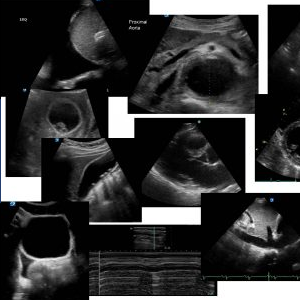
Images and text by Genevieve Carbonatto
An 85 year old presented to our Emergency Department with light headedness fatigue and SOB. BP 90 systolic on arrival, HR 100/min
Bloods: haemoglobin of 78g/l, creatinine of 172micromol/l and urea of 13.9mmol/l. Haemoglobin 3 weeks prior to admission 90g/l.
Past history of AAA endovascular repair 4 years ago, history of PR bleeding 5 years earlier. All investigations so far are negative for the cause of anaemia including gastroscopy and endoscopy. He had not followed up on his yearly vascular ultrasound check of his aortic graft
Longitudinal view of the aorta:



Transverse view at the level of the graft trouser legs
Ultrasound shows a very large aneurysmal native aorta over 7 cm in diameter surrounding the endovascular graft. At the level of the trouser leg iliac graft there is extensive thrombus surrounding the trouser legs.
CT confirmed the large aneurysmal sac surrounding the trouser leg graft and an extraluminal contrast at the level of L3 and L4 raising concern for a type 2 endoleak supplied by a lumbar artery. Also, a Type 3 endoleak was found posterior to the right iliac graft and at the junction of the left iliac graft.
Discussion:
Endovascular aneurysm repair (EVAR) is complicated by endoleaks in 20 to 25% of patients. This is a potentially serious complication which may lead to abdominal aortic rupture. There are five different types of endoleaks, which are classified based on the source of vessels that causes the inflow into the aneurysm sac
Types of endoleaks: 
- Type I endoleaks are leaks at the proximal or distal attachment sites.
- Type II endoleaks are caused by retrograde flow through collateral vessels into the aneurysm sac.
- Type III endoleaks are holes, defects, or separations in the stent-graft material.
- Type IV endoleaks represent porous graft walls.
- Type V endoleaks have been described as being due to endotension with an enlarging aneurysm sac without a visible endoleak.
Endovascular aneurysm repair results in aneurysmal shrinkage in most patients. 2. If the aneurysmal sac does not shrink or if it enlarges then the possibility of an endoleak needs to be entertained. Endotension is a situation where an endoleak does not exist but high postoperative intrasac pressures are present which may lead to enlargement of the aneurysmal sac.
Teaching Point
It is worthwhile scanning the aorta of patients presenting to the Emergency Department who have had an endovascular repair to look at the size of the native aorta especially if there has not been ongoing yearly vascular ultrasound follow up. An enlarged aneurysmal sac should prompt formal vascular ultrasound investigation.
References
- Semin Intervent Radiol. 2009 Mar; 26(1): 33–38. Management of Endoleaks following Endovascular Aneurysm Repair Sarah B. White, M.D.1 and William Stavropoulos, M.D.1
- Journal of vascular medicine Volume 43, Issue 1, Pages 2–7 Abdominal aortic aneurysm sac shrinkage after endovascular aneurysm repair: Correlation with chronic sac pressure measurement Sharif H. Ellozy, MD, Alfio Carroccio, MD, Robert A. Lookstein, MD, Tikva S. Jacobs, MD, Michael D. Addis, MD, Victoria J. Teodorescu, MD, Michael L. Marin,
- Ann Surg. 2004 Jun; 239(6): 800–807.Endoleak Following Endovascular Abdominal Aortic Aneurysm Repair Implications for Duration of Screening Matthew A. Corriere, MD, Irene D. Feurer, PhD, Stacey Y. Becker, RN, Jeffery B. Dattilo, MD, Marc A. Passman, MD, Raul J. Guzman, MD, and Thomas C. Naslund, MD
- Vascular Med.2008; 13:305-311 Endotension following endovascular repair Naoki Toya, Tetsuji Fujita, Yuki kanoaka, Takao Ohki
- Gastrointestinal Complications of Abdominal Aortic Aneurysms, Intech: Emmeline Nugent and Paul Neary National Surgical Training Centre, Royal College of Surgeons in Ireland Ireland




